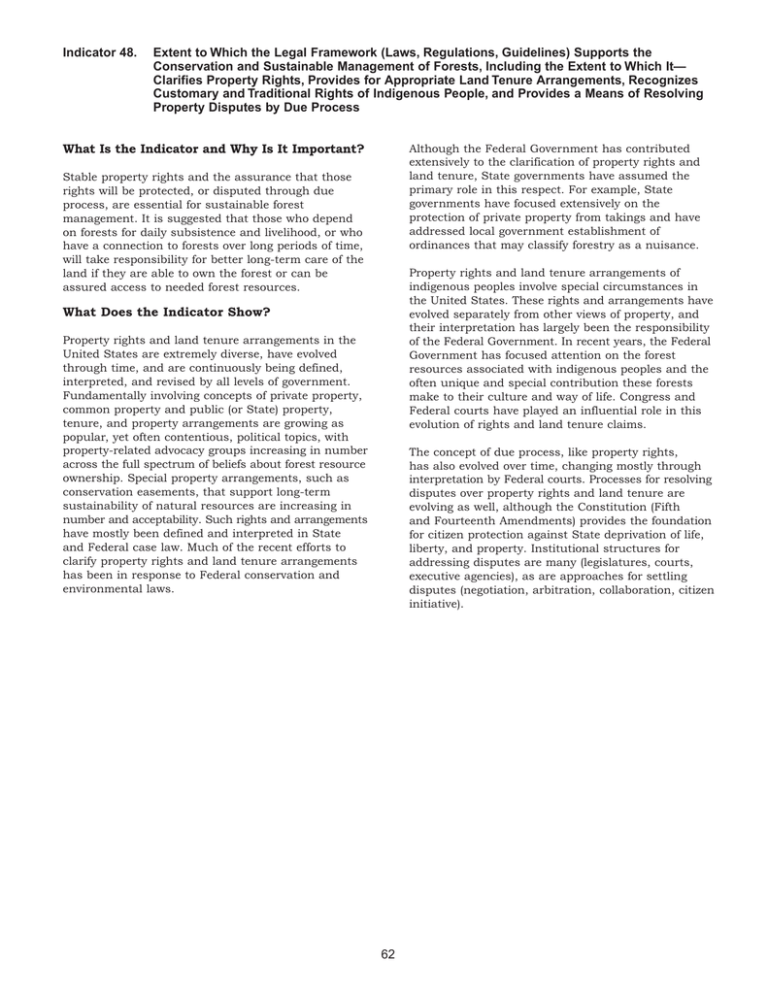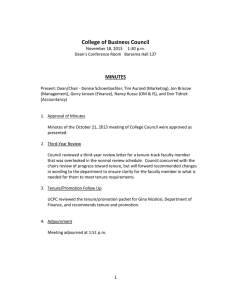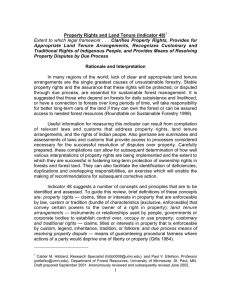Indicator 48.
advertisement

Indicator 48. Extent to Which the Legal Framework (Laws, Regulations, Guidelines) Supports the Conservation and Sustainable Management of Forests, Including the Extent to Which It— Clarifies Property Rights, Provides for Appropriate Land Tenure Arrangements, Recognizes Customary and Traditional Rights of Indigenous People, and Provides a Means of Resolving Property Disputes by Due Process What Is the Indicator and Why Is It Important? Although the Federal Government has contributed extensively to the clarification of property rights and land tenure, State governments have assumed the primary role in this respect. For example, State governments have focused extensively on the protection of private property from takings and have addressed local government establishment of ordinances that may classify forestry as a nuisance. Stable property rights and the assurance that those rights will be protected, or disputed through due process, are essential for sustainable forest management. It is suggested that those who depend on forests for daily subsistence and livelihood, or who have a connection to forests over long periods of time, will take responsibility for better long-term care of the land if they are able to own the forest or can be assured access to needed forest resources. Property rights and land tenure arrangements of indigenous peoples involve special circumstances in the United States. These rights and arrangements have evolved separately from other views of property, and their interpretation has largely been the responsibility of the Federal Government. In recent years, the Federal Government has focused attention on the forest resources associated with indigenous peoples and the often unique and special contribution these forests make to their culture and way of life. Congress and Federal courts have played an influential role in this evolution of rights and land tenure claims. What Does the Indicator Show? Property rights and land tenure arrangements in the United States are extremely diverse, have evolved through time, and are continuously being defined, interpreted, and revised by all levels of government. Fundamentally involving concepts of private property, common property and public (or State) property, tenure, and property arrangements are growing as popular, yet often contentious, political topics, with property-related advocacy groups increasing in number across the full spectrum of beliefs about forest resource ownership. Special property arrangements, such as conservation easements, that support long-term sustainability of natural resources are increasing in number and acceptability. Such rights and arrangements have mostly been defined and interpreted in State and Federal case law. Much of the recent efforts to clarify property rights and land tenure arrangements has been in response to Federal conservation and environmental laws. The concept of due process, like property rights, has also evolved over time, changing mostly through interpretation by Federal courts. Processes for resolving disputes over property rights and land tenure are evolving as well, although the Constitution (Fifth and Fourteenth Amendments) provides the foundation for citizen protection against State deprivation of life, liberty, and property. Institutional structures for addressing disputes are many (legislatures, courts, executive agencies), as are approaches for settling disputes (negotiation, arbitration, collaboration, citizen initiative). 62


